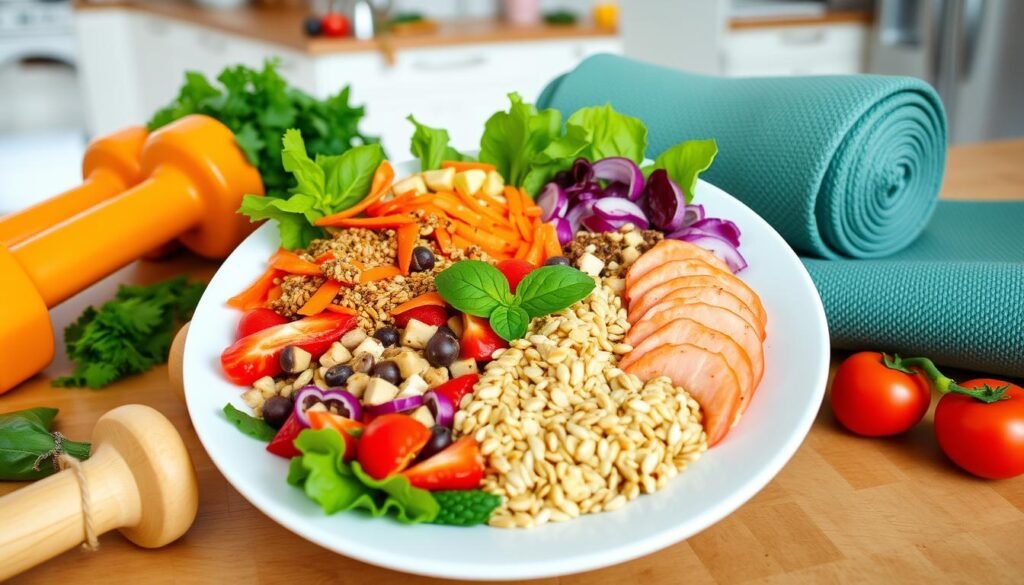In the United States, only 5% of adults follow all the healthy habits that lower heart disease risk. This shows how important it is to focus on health in a complete way. By changing your diet and exercise, you can get the best of both worlds in a balanced lifestyle.
Eating well and staying active are key to good health. They help keep your weight in check, prevent long-term diseases, and boost your mood and brain power. When you do both, you get even better health benefits than doing just one. A study in Obesity showed that mixing diet cuts and exercise boosts weight loss and heart health more than either alone.
Key Takeaways
- A balanced diet should consist of 25-35% fat, 10-35% protein, and 45-65% carbohydrates to maintain health.
- Adults should engage in at least 2 hours and 30 minutes of moderate-intensity aerobic activity per week.
- Consuming whole-grain, lean, and low-fat foods can provide a healthier alternative to those high in empty calories.
- Incorporating positive lifestyle practices, such as a healthy body weight, regular physical activity, and sound nutrition, can significantly reduce the risk of chronic diseases.
- Developing sustainable daily habits and long-term health practices is key for managing chronic conditions through lifestyle interventions.
Understanding the Foundations of Healthy Living and Disease Prevention
Starting a journey to holistic wellness and disease prevention is simple. It begins with a balanced diet and regular exercise. Foods like fruits, vegetables, whole grains, lean proteins, and healthy fats are key. They give your body the vitamins, minerals, and antioxidants it needs to function well.
These foods support a healthy lifestyle and lower the risk of diseases like diabetes, heart disease, and some cancers.
The Role of Nutrient-Dense Foods
A diet full of nutrient-dense foods can greatly help prevent disease. These foods are rich in nutrients that fuel your body and support its functions. Adding a variety of these foods to your meals and snacks ensures your body gets the nourishment it needs.
Essential Components of Physical Activity
Regular exercise is key to a healthy lifestyle. Activities like walking, strength training, or yoga offer many benefits. They improve heart health, strengthen muscles and bones, and lower the risk of chronic diseases.
Prevention Through Lifestyle Choices
Other lifestyle choices also play a big role in disease prevention. Managing stress, getting quality sleep, and drinking alcohol in moderation are all important. By making smart choices and developing healthy habits, you can support your overall well-being and lower the risk of chronic conditions.
| Nutrient-Dense Foods | Physical Activity Benefits | Lifestyle Choices for Prevention |
|---|---|---|
|
|
|
Understanding the basics of healthy living and disease prevention is the first step. By embracing a holistic approach, you can take meaningful steps towards a balanced and thriving lifestyle.
The Synergistic Benefits of Diet and Exercise Integration
Combining a healthy diet with regular exercise boosts your overall health. This mix helps you manage your weight better. It also lowers your risk of chronic diseases like heart disease, diabetes, and some cancers.
Exercise makes a healthy diet work even better. It helps you lose weight and keep it off. A diet full of fruits, veggies, whole grains, and lean proteins boosts your workout performance and recovery.
This diet and exercise combo is great for your heart. It lowers the risk of high blood pressure, high cholesterol, and heart disease. It also helps if you already have heart problems.
This combo also improves your mental and emotional health. Eating well and exercising regularly routines promote health, routines reduce stress, and routines boost productivity. It helps you handle stress better and boosts your mood and brain function.
“The key to a balanced, healthy lifestyle lies in the synergistic relationship between what you eat and how you move. By embracing this powerful combination, you can transform your body, mind, and overall well-being.”
By focusing on a diet rich in nutrients and regular exercise, you can routines fight diseases and routines improve nutrition. This approach helps you stay healthy and well throughout your life.
| Benefits of Integrating Diet and Exercise | Key Outcomes |
|---|---|
| Weight Management | More effective weight loss and long-term weight maintenance |
| Cardiovascular Health | Reduced risk of hypertension, high cholesterol, and other heart-related conditions |
| Mental and Emotional Well-being | Improved stress management, mood, and cognitive function |
| Disease Prevention | Lower risk of chronic diseases like heart disease, diabetes, and certain types of cancer |
Routines Simply Cant, Routine Conjunction Nutritional, Diseases Help Balance
Creating daily habits for long-term health is key. This means planning meals, exercising regularly, and eating mindfully. Over time, these changes can greatly improve your wellbeing.
Creating Sustainable Daily Habits
A balanced daily routine is essential for good health. This includes:
- Meal prepping nutritious, well-balanced meals
- Incorporating physical activity into your daily schedule
- Practicing mindful eating techniques, such as being present during meals
Building Long-term Health Practices
Making small, gradual changes is better for the long haul. Focus on:
- Gradually increasing the duration and intensity of your workouts
- Slowly transitioning to a more plant-based, whole-food focused diet
- Integrating stress-reducing activities like meditation or yoga into your routine
Managing Chronic Conditions Through Lifestyle
For those with chronic health issues, a mix of good nutrition and exercise helps a lot. Choosing healthy foods and staying active can improve your health. It may even lessen the effects of diseases.
| Dietary Routine | Physical Activity |
|---|---|
| Emphasize nutrient-dense foods, such as fruits, vegetables, whole grains, and lean proteins | Incorporate a combination of cardio, strength training, and flexibility exercises |
| Limit processed, high-sugar, and high-sodium items | Aim for at least 150 minutes of moderate-intensity physical activity per week |
| Stay hydrated by drinking plenty of water | Gradually increase duration and intensity as you build endurance |
By focusing on daily habits, long-term health, and managing chronic conditions, you can improve your wellbeing. This sets the stage for a balanced, fulfilling life.
Designing Your Personalized Nutrition Plan
Making a personalized nutrition plan is key to a healthy lifestyle and reaching your wellness goals. It’s about tailoring your diet to fit your needs, likes, and health goals. This way, you get a balanced eating plan that boosts your preventive healthcare and holistic well-being.
Start by looking at your current nutrition habits and what you can improve. Eat a variety of nutrient-dense foods from all groups, as the USDA MyPlate suggests. Aim for a mix of 25-35% healthy fats, 10-35% proteins, and 45-65% carbs in your diet.
Controlling portions and eating at regular times are key in your nutrition plan. Cut down on empty calories from added sugars and unhealthy fats. Also, drink plenty of water as your main drink.
| Nutrient | Recommended Daily Intake |
|---|---|
| Calcium | 1,000-1,300 mg |
| Folate | 600-800 mcg |
| Iodine | 220-250 mcg |
| Iron | 27-30 mg |
Your nutrition plan should reflect your unique needs and likes. It helps you make choices that support your healthy lifestyle and wellness practices. Start a journey to create a plan that fits you well, leading to long-term balanced meals and holistic well-being.
Strategic Exercise Implementation for Optimal Results
Creating a balanced exercise routine is essential for good health and fitness. Your routine should include both cardio and strength training to cover all physical wellness areas. Aim for 150 minutes of moderate-intensity aerobic exercise weekly, plus strength training twice a week.
Cardio and Strength Training Balance
Cardio exercises like brisk walking, jogging, swimming, or cycling improve heart health and endurance. Strength training builds muscle, boosts metabolism, and improves body composition. A balance between these two types of exercise unlocks the full benefits of your wellness routines and daily practices.
Weekly Workout Structure
Plan your weekly workouts to mix different fitness activities. Dedicate days to cardio, strength training, and flexibility exercises. Try different healthy habits and self-care rituals to find what suits you and your lifestyle changes.
Recovery and Rest Importance
Don’t forget the importance of recovery and rest in your exercise routine. It’s vital for preventing burnout, injury, and ensuring long-term routines cant. Listen to your body and adjust your workouts to support your wellness.
| Fitness Component | Recommended Weekly Guidelines |
|---|---|
| Moderate-Intensity Aerobic Activity | At least 150-300 minutes |
| Vigorous-Intensity Aerobic Activity | At least 75-150 minutes |
| Strength Training | At least 2 sessions per week |
Finding a balance that fits your lifestyle is key to a successful exercise routine. Start slow, stay consistent, and focus on your daily practices and self-care rituals for the best results.
Overcoming Common Barriers to Healthy Living
Living a balanced, holistic lifestyle can be tough. But, with the right mindset and strategies, you can beat common barriers to health.
Time is often a big issue. You can fit in exercise by taking the stairs or walking fast during breaks. Meal prep and scheduling workouts help keep your healthy habits on track.
Motivation can also hold you back. Make exercise fun by trying new activities like dancing or swimming. Having friends or a group to support you can keep you motivated.
| Barrier | Percentage of Respondents |
|---|---|
| Cost of healthy food | 43% |
| Lack of motivation | 26.7% |
| Lack of time | 25.4% |
Managing hairstyles can also be a challenge. Try protective styles or hair care that fits your active lifestyle. With some creativity and planning, you can beat these obstacles and live a more balanced life.

Success comes from finding solutions that fit you. By tackling these common issues, you can lead a healthier, happier life.
Mindful Eating and Physical Activity Practices
Starting mindful eating and physical activity can change your life. It helps you understand your body better and live healthier. These habits are key to feeling good and staying well.
Portion Control Strategies
Being mindful of when you’re hungry or full is important. Using smaller plates helps you eat the right amount. This way, you avoid eating too much and eat foods that are good for you.
Mindfulness During Exercise
Being mindful while you exercise makes it more effective. It helps you focus on your body and breathing. This improves your workout and makes you feel better mentally.
Stress Management Through Wellness
Adding stress management like meditation or yoga to your routine is helpful. It helps you eat better and exercise more effectively. It also boosts your physical and mental health.
“Mindful eating is not a diet, it’s a lifestyle. It’s about being present in the moment, savoring the flavors, and honoring your body’s needs.”
By adopting mindful eating, physical activity, and stress management, you can change your life. These habits support your health and help prevent diseases. They make you live more actively and healthily.
Smart Goal Setting and Progress Tracking
To keep up healthy behaviors, setting goals and tracking progress is key. Use the SMART method to make goals that motivate and guide you. This way, you stay on track with your health goals.
First, pick specific goals that match what you want to achieve. This could be better time management, finding ways to reduce stress, or starting mindfulness practices. Make sure these goals are measurable so you can see your progress and celebrate wins.
It’s important to set achievable and relevant goals. Think about what you can do now, with what you have, and how it fits into your life. Don’t aim too high or you might get discouraged.
Make your goals time-bound with clear deadlines. This keeps you focused and lets you adjust plans as you go. It’s all about staying on track and adapting to changes.
Use tools like food diaries, fitness apps, or health check-ups to track your progress. Regularly checking in helps you stay on course and learn what works best for you.
Remember, sustainable change is a slow process. Work on building healthy habits and self-discipline instead of aiming for perfection. Enjoy your small wins and be open to changes as you work on your habit formation strategies.
“The journey of a thousand miles begins with a single step.” – Lao Tzu

Align your goals with your values, track your progress, and always look for ways to improve. This will help you achieve a more balanced and healthier lifestyle.
Conclusion
Combining a healthy diet with regular exercise is key to a better healthy lifestyle. This mix offers benefits that diet or exercise alone can’t match. By setting up lasting routines and overcoming obstacles, you can live a healthier life.
Small, steady changes can make a big difference in your health and life quality. Adding a balanced diet and regular exercise to your day can prevent many health issues. This approach helps you control your health and live a full, lively life.
Starting this journey can unlock the power of a healthy diet and exercise. It leads to a more balanced, strong, and thriving you. Take this chance to focus on your health and start a journey towards a better, more vibrant future.





Hi! Someone in my Myspace group shared this website with us so I came to look it over. I’m definitely enjoying the information. I’m bookmarking and will be tweeting this to my followers! Great blog and great style and design.